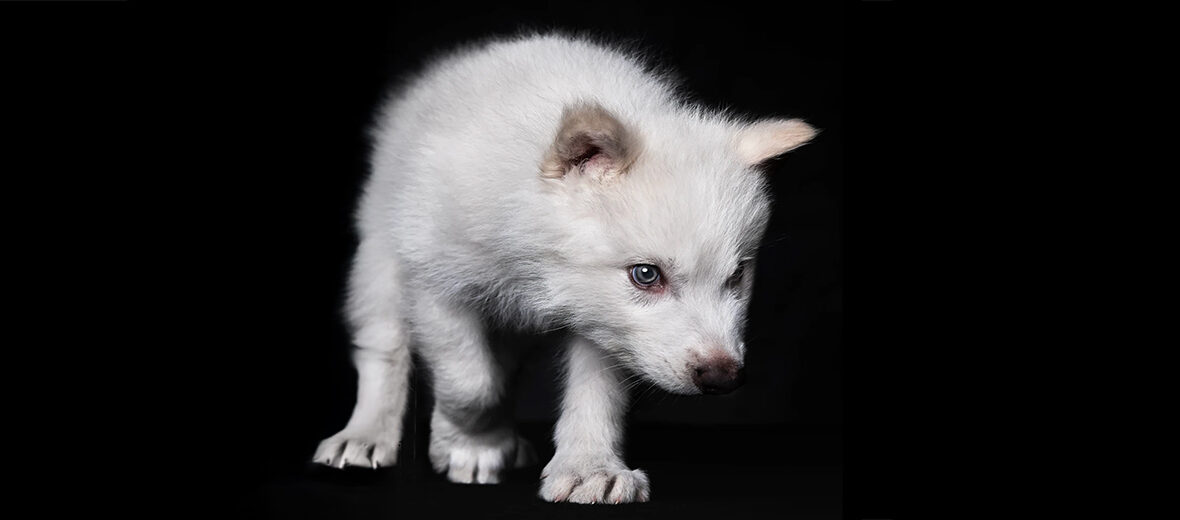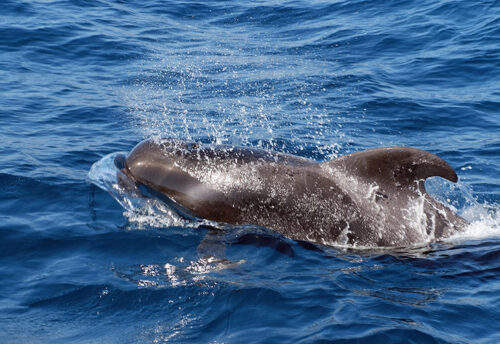
The dire wolf once thrived in the Americas during the Late Pleistocene and Early Holocene epochs (125,000 – 10,000 years ago). However, the challenges they faced brought them to extinction. Attempting to stave off hunters and fighting the drastic effects of climate change proved too much for these canids. Fast forward to the modern era where science is king. In what seems like a scene straight out of the movies, a company called Colossal Biosciences, a Dallas-based biotech company, using ancient DNA and gene-editing technology created 3 pups with traits of the extinct dire wolves.
First the Stats…
Scientific name: Aenocyon dirus
Weight: Up to 150 lbs +/-
Length: Up to 6 feet
Height: Up to 3.5 feet, at the shoulders
Lifespan: Up to 8+ years
Now on to the Facts!
1.) The biggest collection of their fossils was obtained from the Rancho La Brea Tar Pits in Los Angeles, California.
2.) Their skull and dentition are similar to that of the grey wolf, but the canine teeth are sharper and they also have a greater bite force.
3.) Prey was known to have included western horses, ground sloths, mastodons, ancient bison, and camels.
4.) Climate change and the mass depletion of megaherbivores (herbivores weighing up to and over 2,200 lbs.) proved too great a challenge for dire wolves to outlast and they went extinct about 10,000 years ago.
5.) After numerous misnaming events the scientific name of the dire wolf was finally carved in stone as Aenocyon dirus.
But wait, there’s more on the dire wolf!
6.) Their ancestral lineage is debated, with 2 competing theories. The 1st theory, based on fossil morphology, indicates that an expansion of the genus Canis came out of Eurasia and led to the dire wolf. The 2nd theory, based on DNA evidence, states that the dire wolves arose from an ancestral lineage that originated in the Americas and was actually separate from the genus Canis.
7.) The dire wolf has smaller feet and a larger head when compared with northern wolves of the same body size.
Did you know…?
In North America, the canid family came into existence 40 million years ago, and the canine subfamily Caninae roughly 32 million years ago.
8.) Dire wolves are hypercarnivores (an animal that has a diet that is more than 70% meat), with a skull and dentition (teeth) adapted for hunting large and struggling prey; the shape of its skull and snout also changed across time, and changes in the size of its body have been correlated with climate fluctuations.
9.) Fossil evidence from the Americas points to the extinction primarily of large animals, coined Pleistocene megafauna, near the end of the last glaciation event.
10.) The Rancho La Brea tar pits located near Los Angeles in Southern California are a collection of pits of thick, sticky asphalt (tar) deposits that differ in deposition time from 40,000 – 12,000 years before present (YBP).
But wait, there’s still more on the dire wolf!
11.) Studies of the dire wolf’s bite force have indicated that their bite force was greater than today’s wolf and dog species. Their bite has been estimated to be strong enough to crush bone.
12.) At La Brea, mammals and predatory birds were attracted to dead or dying herbivores (eat plant matter) that had become mired, and then these predators in turn also became trapped in the tar pits.
Did you know…?
Based on fossil evidence, it has been assumed that dire wolves are monogamous (mate for life).
13.) Herbivore entrapment was assumed to have occurred once every 50 years, and for every instance of herbivore remains found in the pits there were an estimated 10 carnivores also trapped.
14.) Based on skeletal remains, it has been presumed that these wolves hunted in large packs.
15.) There is little sexual dimorphism between males and females, sans the obvious genitalia variance.
But wait, there’s still a little more on the dire wolf!
16.) Due to samples of broken teeth, it is a common belief that bones were often chewed upon. This indicates that scavenging was not uncommon.
17.) The most tooth breakage occurs in the spotted hyena which consumes all of its prey including the bones; the least breakage occurred in the African wild dog, and the grey wolf ranked in between these 2 canids.
Did you know…?
Due to the size of these canids, their prey was likely to be as large as 1,320+ lbs.
18.) Past studies have proposed that changes in dire wolf body size correlated with climate fluctuations. As the temperatures waxed and waned and food became more or less available, the increase or decrease of nutrients dictated the size of these wolves.
19.) There is evidence that dire wolves, Smilodons (sabertooth cats), and American lions all competed for the same prey.
20.) The preferred habitats, based on past evidence, were plains, grasslands, forested mountain areas, arid savannahs, and likely steppes. They ranged in elevations from sea level to 7,400 feet.
But wait, we’re still not done with the dire wolf!
21.) Remains are not typically found at high latitudes in North America, with the northernmost record being in southern Canada. Most remains have been found in the United States in Arizona, California, Florida, Idaho, Indiana, Kansas, Kentucky, Missouri, Nebraska, Nevada, New Mexico, Oregon, Pennsylvania, South Carolina, South Dakota, Texas, Utah, Virginia, West Virginia, and Wyoming.
22.) There have also been remains found in Mexico, Central America, and South America.
Did you know…?
Climatic change and competition with other species including over-hunting by newly arrived human hunters or both are to blame for the extinction of dire wolves.
23.) During the Quaternary extinction event around 12,700 YBP, 90 genera of mammals weighing over 97 lbs. became extinct. The extinction of the large carnivores and scavengers is thought to have been directly related to the extinction of the megaherbivore prey upon which they depended.
24.) Grey wolves and coyotes may have survived extinction due to their ability to hybridize with other canids (like the domestic dog) to acquire traits that fight diseases brought by taxa arriving from Eurasia. Reproductive isolation may also have prevented the dire wolves from acquiring these traits.
25.) In April 2025, it was announced that Colossal Biosciences used cloning and gene-editing to birth 3 genetically modified wolf pups, 6 month old males Romulus and Remus & 2 month old female Khaleesi.
But wait, we’re almost done with the dire wolf facts!
26.) Scientists at Colossal analyzed the dire wolf genome, extracted from 2 ancient samples, a 13,000 year old tooth and a 72,000 year old ear bone. After comparing the genomes of gray wolves and dire wolves they were able to identify the genetic differences responsible for the dire wolf’s distinctive traits.
27.) Edits were then made to the genetic code of the grey wolf to replicate those specific traits.
Did you know…?
A single embryo in each surrogate mother took hold, and Romulus & Remus were born in October 2024 after a 65 day gestation (pregnancy). The scheduled cesarean section procedure was repeated with a 3rd surrogate, who birthed Khaleesi.
28.) Domestic dogs were utilized as surrogate mothers for the dire pups. Colossal claims that these minute genetic modifications effectively revive dire wolves as a species, though no ancient dire wolf DNA was actually spliced into the gray wolf’s genome.
29.) All in all, the work was less invasive than the typical cloning process. EPC (Endothelial Progenitor Cells) were first isolated from grey wolf blood samples before scientists rewrote 14 key genes in the cell’s nucleus to express 20 traits claimed to represent the dire wolf phenotype.
30.) 45 engineered ova, which developed into embryos were inserted into the wombs of 2 surrogate hound mixes.
31.) After all is said and done, while these aren’t true, purebred dire wolf pups, rather a hybridized species, this is still a huge step in bringing back long lost and recently lost species (like the white rhinoceros) and gives hope to aiding Critically Endangered animal and plant species.
Now a Short Dire Wolf Video!
Be sure to share & comment below! Also, check out the Critter Science YouTube channel. Videos added regularly!
Want to suggest a critter for me to write about? Let me know here.
Some source material acquired from: Wikipedia
Photo credit: Fandom




